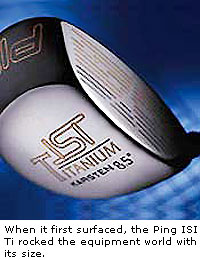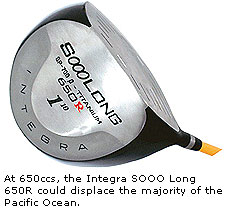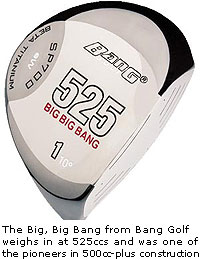Super size me: Driver debate rages

When the Ping ISI Ti first hit the market, consumers were dumbfounded by this thin-walled monstrosity standing before them. At 323 cubic centimeters, surely no one would be able to get this research and development abomination back to square. And the distinct "pop" expelled by the seemingly weightless head and face could be heard on the far reaches of the back nine. This was truly something new to the golfing pop culture.
Now, 323ccs is ancient, and tiny. Progressive equipment consumers cluck their tongues at a driver head so small. "How can anyone hit that? There's no sweet spot," they scoff.
About 100-200ccs and a C.O.R. debate later, driver heads that look like most European cars with a shaft jammed in the tailpipe have appeared ubiquitously under the neon lights of golf retail stores. One is hard-pressed to find anything brand new that weighs in at anything less than 375 to 400ccs.
"Consumers just aren't interested in anything smaller than 400ccs," said Todd Colburn, director of marketing for Cobra.
And now, some smaller club manufacturers have begun pushing the envelope to the practical limit - and past the legal limit.
About three years ago, Bang Golf President Steve Almo submitted his 525cc Big, Big Bang to the United States Golf Association for C.O.R testing, a move that prompted officials' eyes and ears to perk up.
"They didn't realize you could make a head that large," Almo said.
Almo's attempt to expand the equipment horizons backfired, and the USGA handed down a ruling that limits driver head size to no bigger than 470ccs, he said.
"Our sales have slowed a little bit because of the ruling, but not dramatically," Almo said. "Some people just don't care."
 Many other manufacturers have hopped on the super-sized trolley. Integra has made up to a 650cc head. In addition, Hippo, Killer Bee, Dynacraft and a myriad of other no-name producers have eclipsed the 500 mark.
Many other manufacturers have hopped on the super-sized trolley. Integra has made up to a 650cc head. In addition, Hippo, Killer Bee, Dynacraft and a myriad of other no-name producers have eclipsed the 500 mark.
But the larger, pro-line manufacturers seem to be shying away from the 500cc-plus heads - and rightfully so. In a game as traditional as golf, a large equipment company making an illegal club would be a textbook public relations debacle. Either way, most of them feel little to no sense of urgency to actually enter the super-sized market.
"I would guess the market for them to be very small," said Larry Dorman, senior vice president of global public relations for Callaway. "We have no interest in making drivers that exceed USGA specifications."
"It sounds to me like they're trying to reach a niche of customers. I think most golfers want to play within the USGA rules," Cobra's Colburn said. "Golf is a gentleman's game. You're your own referee."
Easy enough. Why not just change the ruling? If there's a better club out there, why not just get the USGA to let players use it? The hot face/C.O.R. debate of recent history nearly changed the rules. Now, size is all the rage. Maybe it will work this time.
"It's about the same chance for changing head size as changing the number of holes to 19," said Dick Rugge, senior technical director with the USGA. "There wouldn't be much support."
To make an amendment to the rulebook, a letter of request must be submitted to the USGA. The request would then find its way into the Equipment Standards Committee. With enough push, it would be passed into the Executive Committee. Not only would the amendment have to receive support there, but it would then have to enter into a similar process with the Royal and Ancient, Rugge said.
"The chance of that happening with head size is something south of zero at this point," he said.
Almo is disenchanted with the USGA's lack of openness.
"It stagnates the golf industry," he said. "They're supposed to preserve the integrity of the game, not dictate the club manufacturers and stagnate creativity."
Not only does the USGA present obstacles to the humongous heads, but the practicality of equipment manufacturing must eventually rear its ugly head.
"There's a benefit to making a larger head if you can make it perform," Colburn said.
"Right now, that's not possible," Dorman said. "When club heads become too big - not properly engineered - they become ineffective."
 Either way, it seems that if 500cc-plus heads are the wave of the future, then titanium is outdated. Instead, composite materials are showing up on the design of some pro-line clubs. The Callaway C4, despite its retail flop, opened up new doors for driver head materials, and this year, the ERC Fusion walked through. And this must be the way manufacturers have to venture if they want to continue this upward trend in size, Colburn said.
Either way, it seems that if 500cc-plus heads are the wave of the future, then titanium is outdated. Instead, composite materials are showing up on the design of some pro-line clubs. The Callaway C4, despite its retail flop, opened up new doors for driver head materials, and this year, the ERC Fusion walked through. And this must be the way manufacturers have to venture if they want to continue this upward trend in size, Colburn said.
"Carbon fiber is stronger and stiffer than titanium," he said.
Bang Golf, however, managed to do it with the existing technology. The Big, Big Bang 525cc head is crafted from 90 percent titanium and the rest beta titanium. But this presents structural problems. When making a club head bigger, the same amount of titanium must be used to maintain a light swingweight, so the shell must be thinner. The bigger the club head gets, the thinner - and more vulnerable - the shell becomes.
"The (Big, Big Bang) shell is dented very easily," Almo said. "It's as thin as an eggshell."
In addition, there is a challenge to making John Everyman square such a large head at impact, a problem Bang Golf solved by closing the face slightly.
So with all the obstacles facing manufacturers when making a 500cc-plus monster, why even forge on? Perhaps we've reached the end.
"There is a trend away from the big head," Almo said. "We've pushed the boundary as far as it can go. The only reason we made a 600 is because somebody topped us with a 550."
June 20, 2004
 By
By
William Tipton wrote on: Feb 26, 2012
I hate driver heads that are too big.
They are a joke to look at and if a person needs that big a sweet spot then something tells me that this person isnt doing something right in their swing and needs this huge compensation to make up for it.
Seems to me that such a large sweet spot would tend to make things worse in the long run for new players since they arent being forced to learn to control the club like they should.
If you make a fist and look at it, Ive got old fairway woods that have heads HALF the size of what your looking at and they hit like nobodies business. And they feel great doing it.
I think 350cc...and maybe upwards of 400...ought to be the limit for players who want to make themselves improve and swing the right way.
Reply